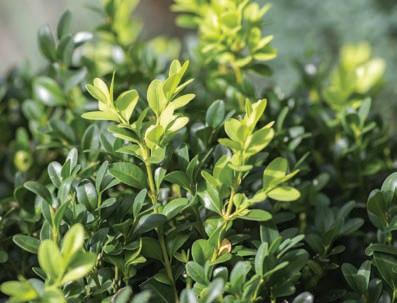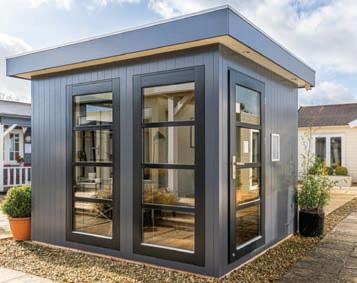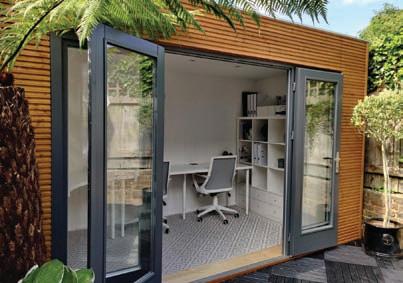
5 minute read
GARDENING
The mirror maze at Royal Fort Gardens. Sculpture is a great way to add your own personality to the garden, whether it’s a stone figurine or something upcycled and rustic

Advertisement
A room with a view

Focal points are vital when designing a garden, providing resting points for our gaze and giving a sense of purpose, says Elly West
The bones of the garden are laid bare at this time of year, revealing new vistas that may have been concealed during the full-grown exuberance of last year. Now is the perfect time to assess your garden’s structure and consider introducing new focal points to add extra interest. Right now our gardens are primarily enjoyed from indoors so consider the view from the main windows that overlook the space. Is there something of interest to look at? And what about when you step outside or look back towards the house from the far end, or from the main seating areas? Think about what there is to see, and where your focus is taken, enticing the feet to follow and making you want to explore.
Focal points are vital when designing a garden. They lead the eye and provide resting points for our gaze, giving a sense of purpose and design. A garden full of plants holds its own charm, but can feel disorganised and busy, with nowhere for the eye to stop and rest. However, a carefully positioned ornament or garden sculpture can provide just as much pleasure as a favourite plant and is a constant all year round, particularly important while many of the plants lie leafless and dormant.
Sculpture is a great way to add your own personality to the garden, whether it’s a traditional stone figurine, a piece of modern art or something upcycled and rustic, such as an interesting piece of driftwood or metalwork. Look around reclamation yards for interesting old pieces of furniture or statuary that can be repurposed in the garden. If you see something you love, then go for it. It’s a great way to have some fun and make your garden distinctively yours. And if you’re that way inclined, it’s also an opportunity to get creative in the garden, perhaps with something home-made such as a mosaic table or bird bath, or some woven willow.
Consider the position of your piece within the garden. Will it be seen all year round, or hidden among the plants and only revealed in winter? What other distractions are there nearby? How will the sunlight catch it at different times of day or year? If you’ve invested in something you really love, you may even want to uplight it artificially to add night-time drama.
Plants also make good focal points, particularly if they are given added prominence in a large container, or a group of containers. Using similar pots around the garden creates harmony and a sense of journey, tying different parts of the garden together, particularly if placed at intervals along a route. Topiary is a good choice for a specimen feature plant, whether it be a simple spiral or cone created from box or yew, or something more elaborate, such as a beautiful cloud-pruned evergreen. Japanese maples also make good specimen trees, although they drop their leaves in winter so pot-grown plants could be moved somewhere less prominent until the spring.
I’m a big fan of crown-lifting ‘blobby’ shrubs that have outgrown their space and aren’t adding much in terms of beauty to a garden. Take out all the lower branches and leaves, and you may reveal a network of interesting stems leading to a higher spreading canopy, or lollipop if you prefer, creating new space for planting low-growing perennials and bulbs beneath, and turning it into a feature.
A well-placed plant, piece of furniture or ornament can also help to detract from less desirable elements outside of the garden such as overlooking buildings. When a garden has no focal points, the gaze drifts outwards, beyond the boundaries, perhaps to neighbouring houses. A garden with points of discovery keeps the focus inwards.
If your garden is small, then just one focal point may be appropriate. Resist the temptation to place it in the middle, unless you want a very formal look, and instead think about the rule of thirds and choose a spot off-centre. Smaller sculptures nestled within a border can create surprise and a sense of discovery, or draw the eye if placed within a wall nook or archway. Larger gardens may benefit from several focal points, one leading to the next, so that you don't take in the whole garden at once.
Decorating your garden with sculpture, furniture, ornaments and specimen plants is an instant way to give it a boost at this cold and unenticing time of year. And if you want to get out and about and see some sculpture, albeit on a larger scale than most of us would have at home, then visit the Royal Fort Gardens in Clifton for installations including the mirror maze, designed by Jeppe Hein, and Kate Paterson’s wooden structure, Hollow.
• ellyswellies.co.uk; Instagram: @ellyswellies1
Plant of the month: Box
Box, or Buxus sempervirens, remains my all-time favourite for topiary and low hedging, as it’s tough, can cope with sun or shade, and can be clipped into all kinds of shapes and sizes. With its tightly packed evergreen leaves, it’s still the classic go-to for balls, spirals, cones and even animals and objects, and as such makes a great feature plant that suits formal and cottage gardens alike. It’s also very long-lived –my parents’ current garden has huge box ‘balls’ probably three or four metres or so in diameter, which have been there since my childhood 40-plus years ago – and they were equally enormous back then. However, if you're thinking of planting box in your garden, take a look around your neighbourhood to see if other gardens have healthy specimens, as box has had a lot of bad press in recent years because of some problems associated with it, especially in London and the South East where many garden designers have stopped using it completely. Box blight is the most common disease –a fungus that turns the leaves brown and causes bare patches. More worrying, perhaps, is the box tree caterpillar, first spotted in gardens in 2011, which can completely defoliate a plant. Fortunately it doesn’t seem to be a problem in the South West as of yet, but if you’re worried then good alternatives include Ilex crenata and Euonymus japonicus.














